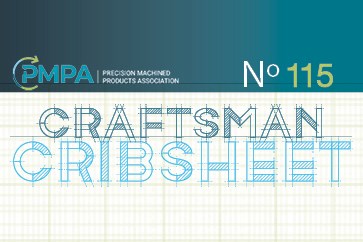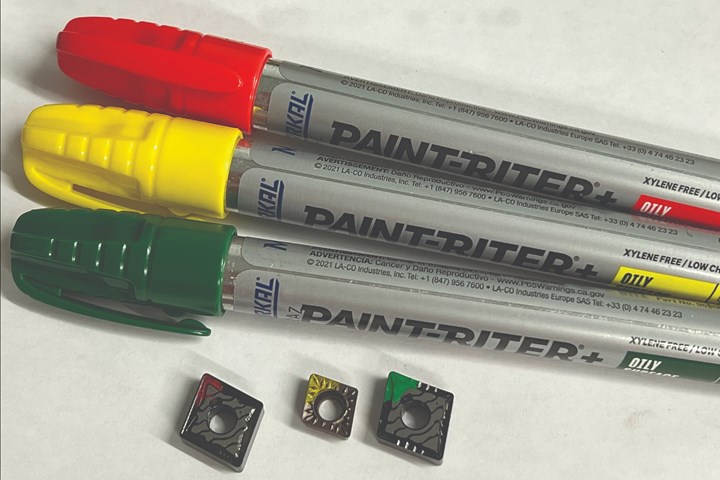Craftsman Cribsheet No.115: Paint Your Edge to Gain an Edge!
Kindergarten skills for the shop. Do you color your inserts?

This is not a discussion of children coloring their coloring page inserts from a children’s book. I am literally asking how many of you out in the shop color your carbide inserts. If you don’t color them, then how do you know what edge is good? What edge is bad? This is a simple visual management tool to help our shop performers identify the edges that will result in trouble-free production. No matter when you go back to a holder, you always know where that insert stands. Visual management gives an immediate positive report on the status of the tool. No more guessing if the edge has been previously used. It looks good. How do we know?
It is often hard to tell when an insert is worn. The obvious ones are the chipped out or cracked in half. How about when you get a job that requires tight surface finish requirements and a worn insert is totally unnoticeable other than the resulting cut. This is where a paint marker designed to mark on oily surfaces comes in handy.
The simplest solution is a one-color system. Red for a bad edge and that is it. But consider a three-colored approach to enable the most life out of your inserts:
- Red for bad edge. You are not using this edge again no matter what. Used 90% of the time.
- Yellow for reusable edge. You would not use a yellow edge on a part that needs some super surface finish or tight tolerance, but when you have a ± 0.015" bushing and just need a cutoff insert, this will definitely work. Used about 7% of the time.
- Green for good edge but has been used. This is reserved for only those times you go to the lathe and drill a hole in a 12L14 or 360 brass ejector. This drill is still brand new, but the color lets us know it has been used. Used less than 3% of the time.
The next time you go to a drawer and look at a load of holders and wonder which of these inserts are used, look for your colored edge so that you know. Better yet, put the inserts away instead of leaving them in the holder. Now you can go to a box of inserts and easily see how many edges you really have. How many times have you ordered a box of inserts only to find 10 holders with that insert already in it? Visual management by applying simple color codes to your tooling will save you thousands of wasted dollars in inserts of uncertain status, locked up in holders.
So, add a little color the next time you go to change an insert. Add a little color and you will always have confidence in the status of your edge. Use visual management to give you an edge!
Related Content
-
Craftsman Cribsheet No. 129: How to Beat the Heat
Shops tend to heat up in the summer. Here are some tips for staying cool in the warmer months.
-
Craftsman Cribsheet No. 126: AISI System of Identification
Source: PMPA Prior to the Society of Automotive Engineers taking responsibility for Steel Grade nomenclature in the United States (1995), the American Iron and Steel Institute determined U.S. standard steel grades in collaboration with SAE.
-
Precision Ground Barstock: How It Is Manufactured, Benefits to Your Shop
Understanding the benefits provided by precision centerless ground barstock can help you avoid false economy and optimize the work you quote by maximizing benefits to your manufacturing process and customer.
















